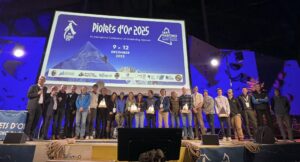As we saw yesterday, some aim to climb the highest peak; some others go for the most difficult. Voytek Kurtyka, transcendental to the point of obsession in his search for the essence in nature, wanted to climb the most beautiful mountain face he had ever seen. The Shining Wall.
The west face of Gasherbrum IV, in the heart of the Karakorum, gets its nickname from the dazzling reflection of sunset light on the 2,500m wall. More than a stunning view, it remains one of the greatest challenges in Himalayan climbing.

Voytek Kurtyka, a paradigm of climbing excellence.
In the 1980s, five teams tried and failed to climb the wall. Kurtyka was determined to solve the riddle. He first proposed the idea to Jerzy Kukuzcka but finally chose Austrian Robert Schauer, a veteran of five 8,000m peaks, including a new route up Nanga Parbat, as his companion.
The pair trekked to the Gasherbrum Massif in summer 1984, in order to study the face and pick a route for the following year. Interestingly, they decided to try a line up the right side of the face, instead of following the crest of a spur that had caught the eye of previous (and later) teams.
They also opted for a pure alpine style, minimalist and utterly bold. After reaching the base of the face and looking up at apparently clear skies, they jumped onto the wall with minimal gear: a rope, some hardware, a bivy sack, food, and a stove. On the first section, up a snowy couloir, they only took out the rope around midface, when they reached the “shiny” part of the wall. Here, as Bernadette McDonald points out in Freedom Climbers, the problems began. The wall reflected the light of the sun so strikingly because it consisted of smooth, fragile, marble slabs.

Kurtyka and Schauer’s route, first up a snow gully and then across across the shining marble face.
The pair climbed highly difficult pitches, with at least three sections over Grade V on either smooth or rotten rock. They were aware that most of their belays wouldn’t stand a fall. For six long days, they advanced farther and farther, beyond any point of return. The bivouacs on tiny ledges without proper sleeping bags gave them little rest after exhausting days, both physically and mentally. Each morning, they just continued up the face without really knowing if they would reach an impossible barrier. Despite everything, they made it to the upper snowfields. And then, it started to snow.

Kurtyka leads a pitch midwall. Photo: Robert Schauer
At 7,800m, with not enough gear left to rappel down the face, retreat was simply not an option. But in the whiteout and fierce winds, neither was further progress. So they just stayed put, waiting for the storm to abate. Two days later, they had still not moved.
Out of fuel, they couldn’t melt snow for water and had no food left, either. McDonald describes how a hallucinating Schauer believed that there was a third member of the team, determined to kill them by pushing them into the void. The Austrian climber later recalled that he saw himself transformed into a raven, looking at his own corpse from above. Kurtyka himself went in and out of consciousness. When he was awake, he focused on his imminent death, which he accepted with dignity and calm.
Still, they had to try to reach the ridge. Eventually, the clouds cleared, giving way to a starry night and sunny morning. Moving their nearly frozen limbs was hard, and it was even harder to advance through the thigh-deep snow. Somehow, they managed to crest the ridge and reached what they later realized was the north summit.
It was late afternoon, and the peak’s main summit lay some 25m above. But they didn’t even consider going for it and simply started rappelling down. There was an excruciatingly long way to go for two exhausted creatures barely able to move. The descent would take them three more days.
Halfway down, hallucinations overtook them both: Kurtyka also felt, rather than saw, the ghostly third man on the team. It required nearly a miracle of human endurance to reach a food cache that they had left at 7,100m during the acclimatization phase. When they finally stumbled into Base Camp, they just collapsed.

Kurtyka on one of many sticky bits.
There was no summit to claim on that adventure. And yet, Climbing magazine considered the feat the greatest climb of the 20th century. The late Doug Scott praised the purity of style performed on “the most technically difficult rock and ice ever climbed at that altitude.” Kurtyka, who had long regretted not reaching the summit, finally understood the climb not as a sports achievement, but as a work of art, in which the lack of a summit acquired a different dimension: “Only in art does a missing link contribute to the meaning of a piece,” he said. Read more about Kurtyka’s life and climbing in the Art of Freedom.
A Korean team climbed the Shining Wall all the way to the summit 12 years later, via a different route (the obvious central spur) and in siege expedition style. Kurtyka and Schauer’s feat remains unparalleled and unrepeated.

Schauer (left) and Kurtyka never climbed together again but got together in 2016 at the Piolet d’Or awards. Photo: Anna Piunova






